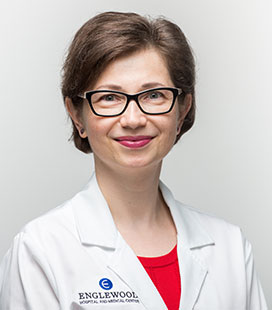
Irina Tartakovsky, MD, internal medicine specialist
Irina Tartakovsky, MD, is an internal medicine specialist with Englewood Health who has been in practice for more than 25 years.
Transitioning your teenager from pediatrician to internist
Around the age of 16—sometimes earlier, sometimes later—most kids start to feel out of place in the pediatrician’s office. As an internist, I take care of young adults age 18 and over. By that age, most feel that they’d like to talk to a doctor one on one, rather than with a parent in the exam room. I leave it up to patients whether they want their parent with them or not; whatever they are comfortable with.
Heading off to college is a big transition, and I like to make it an opportunity to educate my young patients. One of the most important subjects is drugs and alcohol. I try to raise the issue without intimidating them, so they feel comfortable enough to open up and ask questions or express concerns. As they transition into adulthood, they appreciate having someone they can confide in, someone who will address their concerns without preaching.
How can all patients help their doctor take better care of them?
Before you go to an appointment, write down your concerns and questions in order of priority. That way, we can deal with the most important things first.
If something worrisome comes up, don’t wait. Let’s diagnose it, treat it, and deal with it. When patients wait too long before seeking medical help, what started as a simple issue can become more complex and difficult to treat, and the consequences can be more serious.
Why is it important to find a doctor with whom you feel really comfortable and can have an open conversation?
It’s all about the continuity of care. Over time, if you stay with a physician, the continuity of care is what drives that relationship; it takes time to develop trust. The key is that you feel comfortable asking for help and that you have access to the doctor.
Internal medicine is about engaging everyone in a holistic way. The internist is the one who puts it all together for you. We aren’t dealing just with labs and test results; we are dealing with human beings. I try to engage my patients in preventive care, to have them get involved and be their own advocates. This is especially important for patients with chronic conditions, such as hypertension, diabetes, and high cholesterol. I recommend that they be consistent with their follow-up and participate in managing their condition. It’s a long-term commitment to your health—to your life.
Your background brings something special to the care of patients. What made you want to be a doctor?
My family came to the U.S. from Odessa, Ukraine, when I was just under 12 years old, and we settled in Forest Hills, Queens. When I was 12 or 13, my family befriended a physician who helped me to explore the world of medicine. I loved math and science. It was the combination of these things that made me want to be a doctor. From that time forward, I never even thought of doing anything else. Everything I did was always toward that goal of medicine. You know it in the depths of your soul.
What do you consider to be one of the greatest joys of being a physician and an internist, specifically?
My relationships with patients. As an internist, you get to know people on a very deep level. It’s not just their physical health—it’s their emotional health, as well. People open up and say, “I haven’t told anyone about this before.” It shows they are really comfortable and feel they can confide in me as their physician. I have a great appreciation for that, and I never take it for granted. It is very special to me.
Posted September 2018
